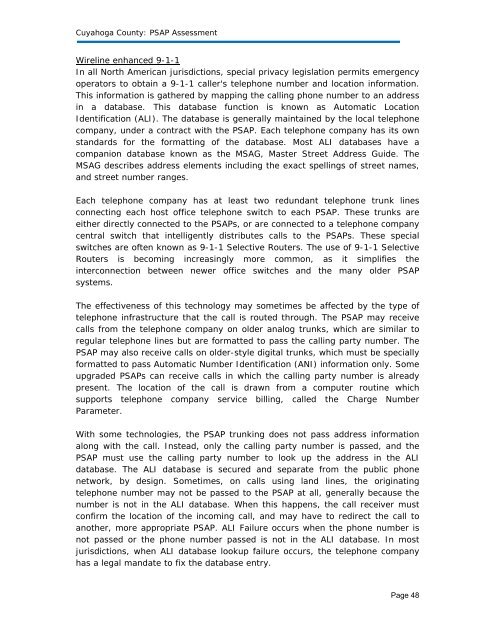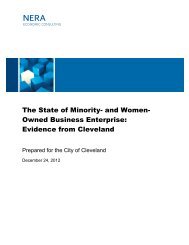Cuyahoga County: Public Safety Answering Point ... - Cleveland.com
Cuyahoga County: Public Safety Answering Point ... - Cleveland.com
Cuyahoga County: Public Safety Answering Point ... - Cleveland.com
Create successful ePaper yourself
Turn your PDF publications into a flip-book with our unique Google optimized e-Paper software.
<strong>Cuyahoga</strong> <strong>County</strong>: PSAP Assessment<br />
Wireline enhanced 9-1-1<br />
In all North American jurisdictions, special privacy legislation permits emergency<br />
operators to obtain a 9-1-1 caller's telephone number and location information.<br />
This information is gathered by mapping the calling phone number to an address<br />
in a database. This database function is known as Automatic Location<br />
Identification (ALI). The database is generally maintained by the local telephone<br />
<strong>com</strong>pany, under a contract with the PSAP. Each telephone <strong>com</strong>pany has its own<br />
standards for the formatting of the database. Most ALI databases have a<br />
<strong>com</strong>panion database known as the MSAG, Master Street Address Guide. The<br />
MSAG describes address elements including the exact spellings of street names,<br />
and street number ranges.<br />
Each telephone <strong>com</strong>pany has at least two redundant telephone trunk lines<br />
connecting each host office telephone switch to each PSAP. These trunks are<br />
either directly connected to the PSAPs, or are connected to a telephone <strong>com</strong>pany<br />
central switch that intelligently distributes calls to the PSAPs. These special<br />
switches are often known as 9-1-1 Selective Routers. The use of 9-1-1 Selective<br />
Routers is be<strong>com</strong>ing increasingly more <strong>com</strong>mon, as it simplifies the<br />
interconnection between newer office switches and the many older PSAP<br />
systems.<br />
The effectiveness of this technology may sometimes be affected by the type of<br />
telephone infrastructure that the call is routed through. The PSAP may receive<br />
calls from the telephone <strong>com</strong>pany on older analog trunks, which are similar to<br />
regular telephone lines but are formatted to pass the calling party number. The<br />
PSAP may also receive calls on older-style digital trunks, which must be specially<br />
formatted to pass Automatic Number Identification (ANI) information only. Some<br />
upgraded PSAPs can receive calls in which the calling party number is already<br />
present. The location of the call is drawn from a <strong>com</strong>puter routine which<br />
supports telephone <strong>com</strong>pany service billing, called the Charge Number<br />
Parameter.<br />
With some technologies, the PSAP trunking does not pass address information<br />
along with the call. Instead, only the calling party number is passed, and the<br />
PSAP must use the calling party number to look up the address in the ALI<br />
database. The ALI database is secured and separate from the public phone<br />
network, by design. Sometimes, on calls using land lines, the originating<br />
telephone number may not be passed to the PSAP at all, generally because the<br />
number is not in the ALI database. When this happens, the call receiver must<br />
confirm the location of the in<strong>com</strong>ing call, and may have to redirect the call to<br />
another, more appropriate PSAP. ALI Failure occurs when the phone number is<br />
not passed or the phone number passed is not in the ALI database. In most<br />
jurisdictions, when ALI database lookup failure occurs, the telephone <strong>com</strong>pany<br />
has a legal mandate to fix the database entry.<br />
Page 48
















